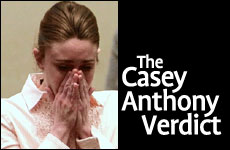 Iran’s Attack on Israel
Iran’s Attack on Israel


5 min read
The standard is proof beyond a reasonable doubt, even if it's 'likely' or 'probable' that she committed murder.
"This case [is] about seeking justice for Caylee . . ." So argued the prosecutor in the Casey Anthony murder case. He was wrong, and the jury understood that.
A criminal trial is never about seeking justice for the victim. If it were, there could be only one verdict: guilty. That's because only one person is on trial in a criminal case, and if that one person is acquitted, then by definition there can be no justice for the victim in that trial.
A criminal trial is neither a whodunit nor a multiple choice test. It is not even a criminal investigation to determine who among various possible suspects might be responsible for a terrible tragedy. In a murder trial, the state, with all of its power, accuses an individual of being the perpetrator of a dastardly act against a victim. The state must prove that accusation by admissible evidence and beyond a reasonable doubt.
Even if it is "likely" or "probable" that a defendant committed the murder, he must be acquitted, because neither likely nor probable satisfies the daunting standard of proof beyond a reasonable doubt. Accordingly, a legally proper result—acquittal in such a case—may not be the same as a morally just result. In such a case, justice has not been done to the victim, but the law has prevailed.
For thousands of years, Western society has insisted that it is better for 10 guilty defendants to go free than for one innocent defendant to be wrongly convicted. This daunting standard finds its roots in the biblical story of Abraham's argument with God about the sinners of Sodom.
Abraham admonishes God for planning to sweep away the innocent along with the guilty and asks Him whether it would be right to condemn the sinners of Sodom if there were 10 or more righteous people among them. God agrees and reassures Abraham that he would spare the city if there were 10 righteous. From this compelling account, the legal standard has emerged.
That is why a criminal trial is not a search for truth. Scientists search for truth. Philosophers search for morality. A criminal trial searches for only one result: proof beyond a reasonable doubt.
A civil trial, on the other hand, seeks justice for the victim. In such a case, the victim sues the alleged perpetrator and need only prove liability by a preponderance of the evidence. In other words, if it is more likely than not that a defendant was the killer, he is found liable, though he cannot be found guilty on that lesser standard.
Casey Anthony was not found innocent of her daughter's murder; she was found "not guilty."
That is why it was perfectly rational, though difficult for many to understand, for a civil jury to have found O.J. Simpson liable to his alleged victim, after a criminal jury had found him not guilty of his murder. It is certainly possible that if the estate of Caylee Anthony were to sue Casey Anthony civilly, a Florida jury might find liability.
Casey Anthony was not found innocent of her daughter's murder, as many commentators seem to believe. She was found "not guilty." And therein lies much of the misunderstanding about the Anthony verdict.
This misunderstanding is exacerbated by the pervasiveness of TV shows about criminal cases. On television and in the movies, crimes are always solved. Nothing is left uncertain. By the end, the viewer knows whodunit. In real life, on the other hand, many murders remain unsolved, and even some that are "solved" to the satisfaction of the police and prosecutors lack sufficient evidence to result in a conviction. The Scottish verdict "not proven" reflects this reality more accurately than its American counterpart, "not guilty."
Because many American murder cases, such as the Casey Anthony trial, are shown on television, they sometimes appear to the public as if they were reality television shows. There is great disappointment, therefore, when the result is a verdict of not guilty. On the old Perry Mason show, the fictional defense lawyer would not only get his client acquitted but he would prove who actually committed the murder. Not so in real life.
The verdict in the Casey Anthony case reflected the lack of forensic evidence and heavy reliance on circumstantial inferences. There was no evidence of a cause of death, the time of death, or the circumstances surrounding the actual death of this young girl. There was sufficient circumstantial evidence from which the jury could have inferred homicide. But a reasonable jury could also have rejected that conclusion, as this jury apparently did. There are hundreds of defendants now in prison, some even on death row, based on less persuasive evidence than was presented in this case.
Juries are not computers. They are composed of human beings who evaluate evidence differently. The prosecutors in this case did the best they could with the evidence they had, though I believe they made a serious mistake in charging Casey Anthony with capital murder and introducing questionable evidence, such as that relating to the "smell of death" inside the trunk of Casey Anthony's car.
The defense also made mistakes, particularly by accusing Ms. Anthony's father of sexually abusing her. Although they leveled this unfounded accusation in an effort to explain why Casey had lied, it sounded like the kind of abuse excuse offered to justify a crime of violence. But a criminal trial is not about who is the better lawyer. It is about the evidence, and the evidence in this case left a reasonable doubt in the mind of all of the jurors. The system worked.
This article originally appeared in The Wall Street Journal.
